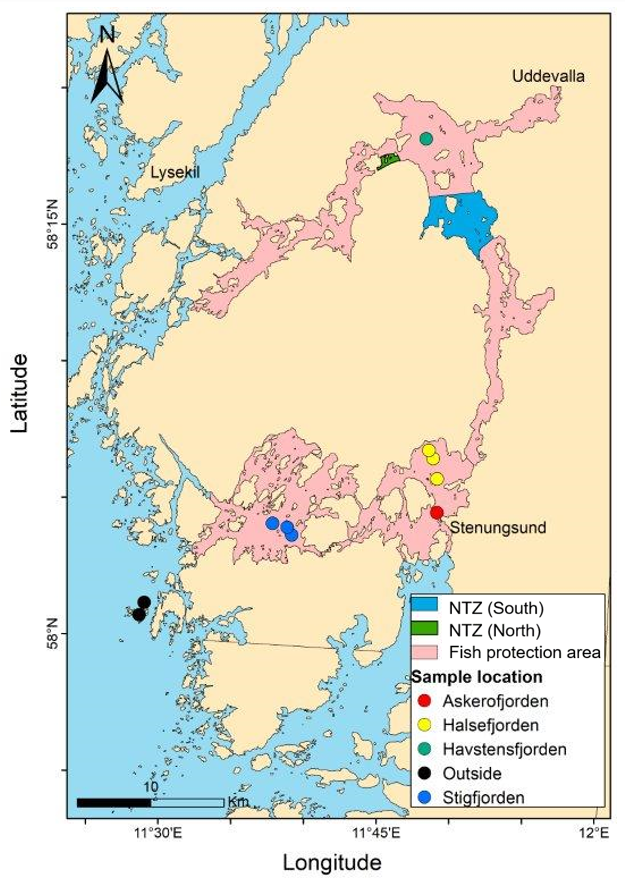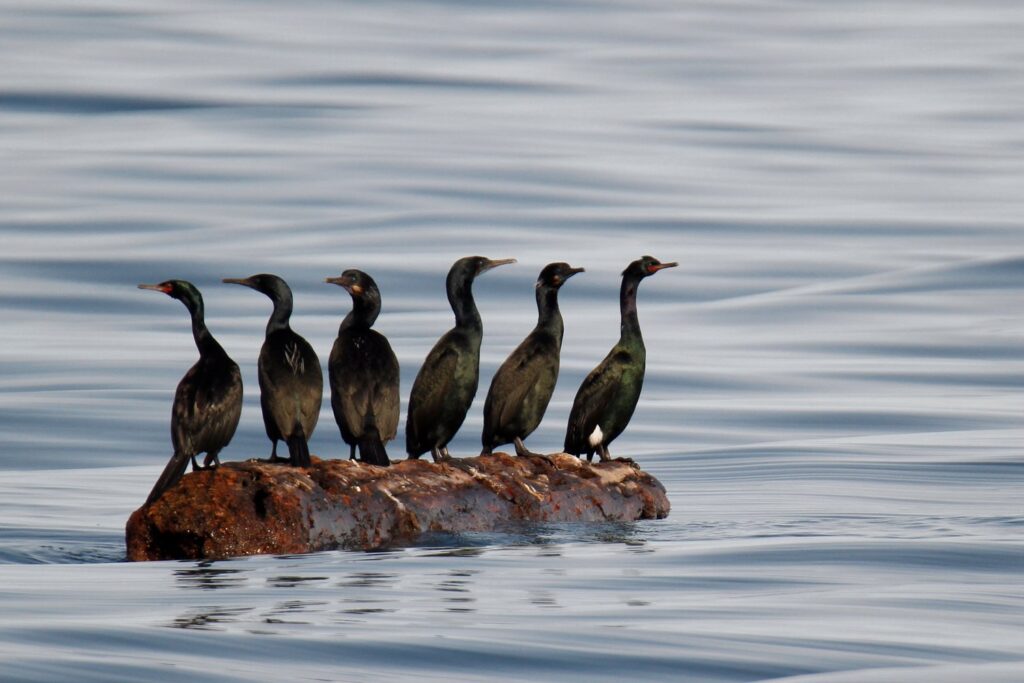Background

Great cormorants (Phalacrocorax carbo) are a species of piscivorous seabirds with a widespread global distribution [1]. They are generalist predators, feeding in a range of aquatic habitats [1] and temporal and spatial shifts in cormorant diet are well documented [2-5]. Due to its opportunistic feeding strategy, the species is considered a competitor for fish stocks as a result of its predation on commercially important species such as cod (Gadus morhua), herring (Clupea harengus), and sprat (Sprattus sprattus), thus creating a human-wildlife conflict in various countries [6].
After coming back from the brink of extinction following European Union level protective legislation [7, 8], cormorant numbers have increased rapidly in the continent, including in my study area of Västra Götaland in Sweden [9, 10]. This region, and more specifically the 8-fjords area, has suffered economically following the collapse of codfish stocks due to overfishing in the 1980s [11-13]. Despite the creation of a fish protection area forbidding the fishing of cod, haddock (Melanogrammus aeglefinus), and pollack (Pollachius pollachius) within the fjords [14], codfish recovery has not been forthcoming [15-17] and thus a “protective” hunt was created in order to shoot cormorants perceived as a threat to these protected species [18].
Cormorant diet may be assessed in several ways: through feeding observations, pellet (mucus covered indigestible prey material which is expelled around once a day) and regurgitate collection and analysis, and stomach contents analysis [1]. Stomach samples provide a direct assessment of consumed prey items but may be subject to biases related to digestion. Previous studies in the 8-fjords worked only with pellet data [19, 20], while this study focuses almost exclusively on stomach samples.
Aims
The aim of this study is to determine the diet composition of cormorants in the 8-fjords area to ascertain their importance as predators of protected fish species.
More specifically the aims of this study are to (1) increase knowledge on cormorant diet composition and contribution of protected fish species to the diet by comparing data from different fjords over multiple years and seasons, (2) compare the information obtained from pellet and stomach analysis, (3) evaluate the differences between fish caught by cormorants and those caught by the monitoring surveys.

References
- Carss, D. (2012). The INTERCAFE Field manual: Research methods for Cormorants, fishes, and the interactions between them. COST, European Cooperation in Science and Technology.
- Lehikoinen, A. (2005). Prey-Switching and Diet of the Great Cormorant during the Breeding Season in the Gulf of Finland. Waterbirds: The International Journal of Waterbird Biology, 28(4), 511–515.
- Lehikoinen, A., Heikinheimo, O., & Lappalainen, A. (2011). Temporal changes in the diet of great cormorant (Phalacrocorax carbo sinensis) on the southern coast of Finland—Comparison with available fish data. Boreal Environment Research, 16 (suppl. B), 61–70.
- Boström, M. K., Lunneryd, S.-G., Ståhlberg, H., Karlsson, L., & Ragnarsson, B. (2012a). Diet of the Great Cormorant (Phalacrocorax carbo sinensis) at two areas at Lövstabukten, South Bothnian Sea, Sweden, based on otolith size-correction factors. Ornis Fennica, 89, 157–169.
- Boström, M. K., Östman, Ö., Bergenius, M. A. J., & Lunneryd, S.-G. (2012b). Cormorant diet in relation to temporal changes in fish communities. ICES Journal of Marine Science, 69(2), 175–183. https://doi.org/10.1093/icesjms/fss002
- Hansson, S., Bergström, U., Bonsdorff, E., Härkönen, T., Jepsen, N., Kautsky, L., Lundström, K., Lunneryd, S.-G., Ovegård, M., Salmi, J., Sendek, D., & Vetemaa, M. (2018). Competition for the fish – fish extraction from the Baltic Sea by humans, aquatic mammals, and birds. ICES Journal of Marine Science, 75(3), 999–1008. https://doi.org/10.1093/icesjms/fsx207
- Cowx, I. G. (2013). Between Fisheries and Bird Conservation: The Cormorant Conflict. Note. Directorate-General for Internal Policies. Policy Department B: Structural and Cohesion Policies. Fisheries. European Parliament.
- Council directive (79/409/EEC) of 2 April 1979 on the conservation of wild birds’ (1979), The Official Journal of the European Communities, L103/1
- van Eerden, M., Parz-Gollner, R., Marion, L., Bregnballe, T., Paquet, J.-Y., Volponi, S., van Rijn, S., & Carss, D. (2022). Numbers of Great Cormorants Phalacrocorax carbo Wintering in the Western Palaearctic in January 2013. Ardea, 109, 271–284. https://doi.org/10.5253/arde.v109i2.a2
- Lundström, K. (2024). Rikstäckande inventering av häckande storskarv (Phalacrocorax carbo) i Sverige 2023 (National census of breeding great cormorants (Phalacrocorax carbo) in Sweden 2023). Aqua notes 2024:7. Uppsala. Sveriges lantbruksuniversitet. https://doi.org/10.54612/a.6tcqoqona2
- Ask, L. & Svedäng, H. (2019). En näring i nationens tjänst – utvecklingen av fisket och fiskeriförvaltningen i Sverige. Havsmiljöinstitutets rapport nr 2019:7
- Svedäng, H. (2003). The inshore demersal fish community on the Swedish Skagerrak coast: Regulation by recruitment from offshore sources. ICES Journal of Marine Science, 60(1), 23–31. https://doi.org/10.1006/jmsc.2002.1329
- Svedäng, H. & Bardon. (2003). Spatial and temporal aspects of the decline in cod (Gadus morhua L.) abundance in the Kattegat and eastern Skagerrak. ICES Journal of Marine Science, 60, 32–37. https://doi.org/10.1006/jmsc.2002.1330
- Länsstyrelsen Västra Götaland, Havs-och Vattenmyndigheten, and Sveriges lantbruksuniversitet. (2017). Cod, fishing regulations and biology. [Brochure]
- Andersson, E., Högvall, J. & Larsson, R. (2021). Kusttrålundersökningen 2021 Expeditionsrapport. Aqua reports 2021:23. Sveriges lantbruksuniversitet, Institutionen för akvatiska resurser, Lysekil 27s
- Wikström, A., Wennhage, H., Andersson, E., Ovegård, M., Högvall, J., Lundström, K. & Svensson, F. (2022). No-take zone for cod and flatfish in the Havstensfjord, Skagerrak. In: Long-term effects of no-take zones in Swedish waters. Bergström, U., Berkström, C. & Sköld, M. (eds.) Aqua reports 2022:20. Swedish University of Agricultural Sciences.
- Thor, P., Olsson, K., Wennhage, H., Lundström, K., Sköld, M., Belgrano, A., Åhlund, M., Uddén, J., Tomczak, M., Magnusson, K., Svensson, F. (2023). Marina miljön i 8+fjordar – nuvarande kunskap om ekosystemet och de mänskliga belastningarna. Aqua reports 2023:11. Lysekil: Institutionen för akvatiska resurser. https://doi.org/10.54612/a.utn1p1g09m
- Länsstyrelsen Västra Götaland. (2021) Tillstånd till skyddsjakt på storskarv i havet inom Västra Götalands län.
- Ljunggren, E. (2017). Prey choice of great cormorants (Phalacrocorax carbo) in a marine protected area: Potential impact on collapsed fish stocks and implications for future monitoring. Master’s Thesis, Uppsala Universitet. https://www.diva-portal.org/smash/get/diva2:1152436/FULLTEXT01.pdf
- Fleet, F. (2021). Diet Composition of Great Cormorants (Phalacrocorax Carbo) in the 8-Fjord Area and Gullmarsfjord. Master’s Thesis. University of Gothenburg.